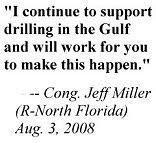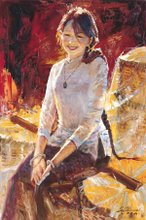 1. Three-Day oil forecast.
1. Three-Day oil forecast.NOAA projects the leading edge of BP's oil spill, nudged by "persistent southerly winds" will continue hugging the coast of Northwest Florida over the next three days. (Click here or on graphic, above, for enlarged view.)
Monday morning on the beach, however, a light, hot wind was blowing north-to-south, just as weatherman Matt Barrentine (Channel 10, Mobile) predicted:
2. Clean beach.
 Despite the new "don't touch oil" warning on the electronic
Despite the new "don't touch oil" warning on the electronic greeting board for those entering the beach (see left), so far today there have been almost no reports of tarballs or oil sheen.
greeting board for those entering the beach (see left), so far today there have been almost no reports of tarballs or oil sheen.Of course, this disappoints all the robots inside the media trucks gathered at Casino Beach (see right). They're waiting impatiently for the chance to break into the news cycle with blood-stirring bulletins of an oil tsunami.
On the other hand, a good many of the human TV crew members we've met have fond personal memories of vacationing on Pensacola Beach. More than a few even lived here for a time in their younger days.
It's plain to see they're just as happy to see the oil stay away. Plus, the rest breaks are more relaxing:
 3. Sarcastic Sand Sculptures.
3. Sarcastic Sand Sculptures.Yesterday, as the local newspaper reports, "sand art" blossomed on the beach. More than one of the sand sculptures in the annual Five Flags Festival contest struck an oily theme.
One incorporated tarballs as the eyes of a large crab. Another was a gargoyle with a sickly green hue named "Mr. BP."
All were still visible this morning. Some were more at risk from the next high tide than any oil.
Our personal favorite, for both aesthetic and political reasons, is the sand art entry submitted by David and Kathy Bosso. Judging from the comments we overheard from discerning beach-goers, it's their favorite, too (click graphic for enlarged view):

4. Tarball Report.
On most of the 15 mile stretch of sugar white sand which we saw this morning there was no sign of oil. Beach walkers, curiosity seekers, surfers, swimmers, sunbathers, lifeguards, and park rangers, all told us they had seen no tarballs or new evidence of oil.
Apparently, however, one report had been made of small tarballs on a stretch of beach just west of Pensacola Beach's "Ft. Pickens Picnic Area," inside the federal park itself.
 This is where we saw two of the best-equipped beach cleaning squads we have witnessed in the past week. They were all outfitted with hazmat suits, armed with appropriate tools and water for today's expected heat index of 105+, and afforded the shade of two tents for frequent breaks.
This is where we saw two of the best-equipped beach cleaning squads we have witnessed in the past week. They were all outfitted with hazmat suits, armed with appropriate tools and water for today's expected heat index of 105+, and afforded the shade of two tents for frequent breaks.That's the way all clean-up crews should be outfitted. But we worry that BP Corp. has subcontracted to other companies much of the beach clean-up responsibility and then defaulted in its responsibility to ensure that subcontractors treat their clean-up employees with fairness and humanity.
5. Bay Booms.
Because the oil arrived last Friday and continues to hang around just offshore, booms now have been stretched at least part-way across the entrance to Pensacola Bay, known as Pensacola Pass, and the much narrower entrance to Little Sabine Bay at Pensacola Beach.
At the pass, frankly, it's hard to see what good they will do. Although the water was unusually calm this morning, most of the time the surface waters at the pass are choppy. That's where most tourists learn whether they're prone to seasickness. Large amounts of oil will have no trouble sloshing over the planned V-shaped boom.
 The boom isn't quite closed at Little Sabine Bay, for good reason. Some charter boats anchored there are still hopeful of customers; many fishing boats have been hired by BP to scout the open Gulf waters for oil slicks. Both need to get in and out of Sabine Bay as well as Pensacola Bay.
The boom isn't quite closed at Little Sabine Bay, for good reason. Some charter boats anchored there are still hopeful of customers; many fishing boats have been hired by BP to scout the open Gulf waters for oil slicks. Both need to get in and out of Sabine Bay as well as Pensacola Bay. 6. Family Values on the Move.
6. Family Values on the Move.Then there are the immigrant swans. They need access to Little Sabine Bay, too.
We happened to encounter a swan family moving into Sabine Bay this morning. Unlike human beings, swans are notoriously monogamous. They usually mate for life, although some Australia researchers think they have detected evidence that some of them are learning bad habits from humans.
Sorry, Arizona, we forgot to ask the swans for their papers. But we assume what we saw this morning was the more usual story-book "traditional American family unit" of a daddy swan, a mommy swan, and a baby swan.
Look carefully. Such an idealized family exists only among swans and in the fevered imaginations of right-wing preachers and hypocritical politicians.

7. EPA air monitors.
While we we re wandering around the western tip of Santa Rosa Island, we spotted a number of multi-gas air quality detectors. They bear the ownership label of the U.S. Environmental Protection Agency and were placed inside the federally-maintained Ft. Pickens portion of the Gulf Islands National Seashore.
re wandering around the western tip of Santa Rosa Island, we spotted a number of multi-gas air quality detectors. They bear the ownership label of the U.S. Environmental Protection Agency and were placed inside the federally-maintained Ft. Pickens portion of the Gulf Islands National Seashore.Not long after, we encountered a two-man team of environmental assessment specialists who also were touring the grounds of Ft. Pickens. They, too, were planning to monitor air quality. They claimed to be working for a private company "under contract" to someone else.
To whom were they under contract? They said they didn't know. But they were most interested in seeing our photos of the EPA's equipment.
One gets the notion, now and then, that BP's left hand doesn't know what the Government's right hand is doing, and vice versa.







3 comments:
It’s wonderfull a addions on Mars Rover.Thanks for sharing it.Keep up
For my part one and all have to go through this.
I found a great deal of helpful info in this post!
Post a Comment